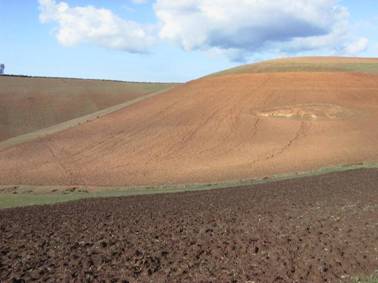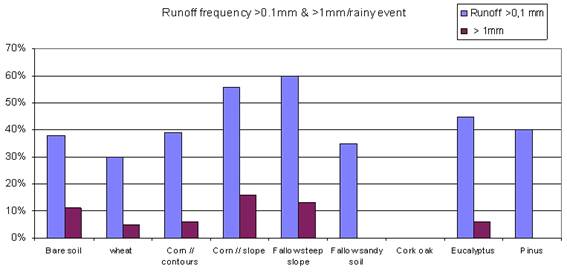Experimental results
Measurement of overland flow
Measuring of overland flow and erosion on plots of 100mē, in combination with rain gauging, gave the following results:
The frequency of an amount of runoff equal or superior to 0.1 mm differs according to land occupation:
- in the forests, the frequency is the lowest (10 to 27% of the total events), in relation with the vegetation density;
- under annual cultivation, the frequency is quite moderate (30 to 40%) if the soil is ploughed along to the contours;
- under a eucalyptus plantation, the erosive rains represent 45% of the events, which means that this kind of vegetation is characterized by high overland flow;
- the highest frequency is reached in the corn plots where the soil is ploughed along the slope. The high runoff is associated with bare, deep and large furrows which have the behaviour of real rills.
In the hilly parts of the commune area, with gentle slopes, the runoff not only has an effect on soil degradation and on productivity, a second effect is more dangerous in relation with the concentration of flow in the drainage network, through rills, gullies and streams. This functioning of the concentrated runoff is recorded in cases of important rains, when the superficial runoff reaches high values.

Figure 10: Effects of runoff on hilly parts of Sehoul commune
50 to 70% of the high runoff happens after successive days of rain; in the bare plots, 40% of the cases in which runoff exceeds 1 mm have recorded more than 30 mm of rain in the days preceding the event.
Comparison of all runoff events yielded the following results. Under well established corn, and wheat cultivation, a high runoff is recorded in only 6 and 3 % of the cases respectively. We conclude that the cultivated fields normally offers a good protection if the land is ploughed carefully and in the right way. The density of crop cover is important and barley or wheat constitute in winter and spring a good protection because they grow early and with a significant density.

Figure 11: Runoff under different types of vegetation cover
But these runoff results are only valid in normal or in dry years. Special events of continuous rain can lead to the saturation of the sandy horizon and produce significant overland flow. Under continuous and intense rains, in the fields in fallow, the grass cover is sufficient to restrict the impact of the runoff events, while the recently ploughed areas record a very important erosion because the wheat is still with a very weak density; on the bare surfaces a rapid development of crusts lead to a rapid and massive runoff.
Measurement of suspended load

Figure 12: Suspended load in runoff under different types of vegetation cover
There is a weak rate of high suspended load in the plots inside the forest or in fallow. The suspended load of the runoff reaches its highest values in the ploughed and cropped fields and, above all, in the fields of corn that are ploughed along the slope.

Figure 13: Soil loss under different types of vegetation cover
Winter cereals provide sufficient protection for the soil; the bare plot records a relatively high rate of erosion, but it remains lower than what is recorded in the fields covered by corn in spring and ploughed many times during a cultivating season. The field ploughed along the slope shows the highest rates. Very low rates were recorded in Eucalypt plantations, except after an shortly after wood cutting.
Rainfall simulation
Rainfall simulation permits to classify the behaviour of fields in order of decreasing runoff:
- old fallow on degraded and abandoned soil generates the most important runoff
- recently ploughed fields rank second, with a rapid destruction of the soil structure, crusting and functioning of rills on the fragile soil,
- fields ploughed very soon in the first days of autumn with a cereal cover
- in fields cultivated the year before, not ploughed in autumn and left fallow the runoff and erosion are very weak.
Ploughing is an important factor of erosion; the comparison between ploughed fields and under fallow shows that under heavy rains of autumn, much more erosion was recorded in the ploughed fields than in fallows. Even when overland flow does occur in fallows, water does not have significant turbidity. This runoff with weak material transport on slopes can be positive and play another role in term of water availability for the dams. At the same time it can cause serious downstream effects and create forms of incision.
The freshly ploughed fields on slopes are the most fragile areas. The differentiation is clear between fields recently ploughed just before the rain and with no cover and others where the cereals have already matured (ploughed very early in autumn) and better hold the soil.
The technique used for ploughing also plays an important role and differentiates between the fields ploughed along the contours and those ploughed according to the slope. The great danger is the monoculture of a whole slope ploughed and on which an intense and continuous rain in autumn occurs.
Synergy of mechanisms
More runoff and soil erosion is recorded on degraded soils record. Runoff and erosion are responsible for soil degradation and reduction of infiltration and hence a decrease of water storage in soils and in the water table.
Water resources degradation
Superficial groundwater resources in the semi-arid agricultural region east of Rabat (Morocco) are declining due to an increasing demand for consumption and irrigation and the limited use of water saving techniques. The recharge of the discontinuous superficial groundwater bodies is fully dependent on infiltrating rain water. Soil degradation by overgrazing, crusting and an efficient drainage network enhance the rapid removal of rainfall excess water in surface runoff, especially in high-intensity rainfall events at the start of the growing season.